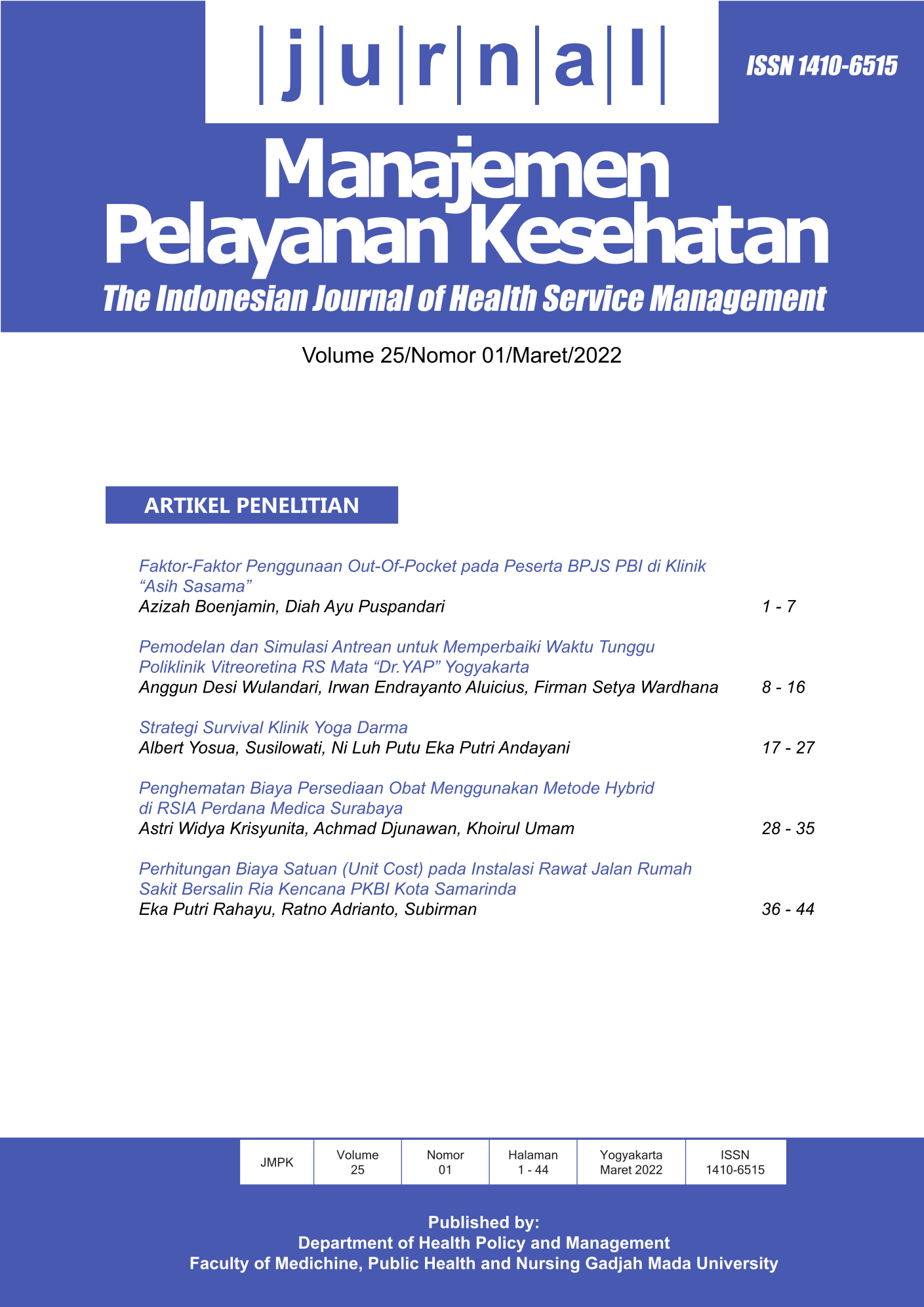PEMODELAN DAN SIMULASI ANTRIAN UNTUK MEMPERBAIKI WAKTU TUNGGU POLIKLINIK VITREORETINA RS MATA “DR.YAP” YOGYAKARTA
Abstract
Background: Queuing problems often occur in the health care industry, such as hospitals. The problem has arisen because many requests access the services, but it is in imbalance with the adequacy of providers. Increased outpatient visits at the vitreoretinal polyclinic at the “Dr. YAP” causes long queues and long waiting times. Meanwhile, waiting time is an essential indicator of service quality in hospitals and affects patient satisfaction. Queueing model and simulation can be one method to identify queuing process problems and find the most optimal queuing scenario.
Objectives: Identify the queuing system model at the vitreoretinal polyclinic service at the “Dr. YAP”, analyze the vitreoretinal polyclinic queuing system’s performance measures, and identify the optimal queuing scenario through simulation to improve the total waiting time.
Methods: This research was conducted in two stages. The first stage is a quantitative descriptive analysis where the queue performance parameters are calculated. Data collection techniques used in this
research are observation to obtain primary data (patient arrival time, service time, and waiting time on each server) and interviews to get supporting data. The second stage is the study of model construction. At this stage, the simulation model is designed to predict changes in patient waiting time for several scenarios using Ms. Excel and JaamSim software.
Results: The queuing system model in the vitreoretinal polyclinic is Multi-Channel Multi-Phase, consisting of 3 queue phases with more than 1 server. A total of 338 patients were served, and the patients’ largest distribution for total waiting time was patients who waited for > 2 hours (41.12%) and between 1-2 hours (37.57%). The longest waiting time is for a doctor’s check-up length of 1 hour and 47 minutes. Several queuing scenarios were made from several identified problems. The first scenario, simulating the doctor’s arrival on time, reduces 25% of the total waiting time to 1 hour and 20 minutes. In the second scenario, separating the laser procedure schedule reduces 4% of the waiting time to 1 hour and 43 minutes. By combining scenarios 1 and 2, the third scenario reduced the total waiting time by 29% to 1 hour and 16 minutes. The fourth scenario is carried out
through modeling on the JaamSim software by adding one doctor and one nurse, and the result is that there is a decrease in waiting time and the number of patients waiting in queues.
Conclusions: Hospitals can take several ways to improve the waiting time. The first is to improve the punctuality of doctor’s practice time. This effort can be made by evaluating the starting hours of a doctor’s
practice following the doctor’s feasibility and using an information system that can send automatic messages to the patients regarding the doctor’s practice start time and the patient’s arrival time. The second is the separation of the queue for laser procedures from the polyclinic queue. Laser procedures for reserved patients can be scheduled before the start of practice, after the practice, or on another day. Third, the addition of a Retinal Subspecialist Doctor and nurses at certain hours when there is no retinal schedule. The doctor is a preferably permanent doctor who has first practice license at the “Dr. YAP” Eye Hospital.
Copyright (c) 2022 Anggun Desi Wulandari, Irwan Endrayanto Aluicius, Firman Setya Wardhana

This work is licensed under a Creative Commons Attribution-NonCommercial-ShareAlike 4.0 International License.

